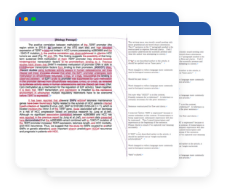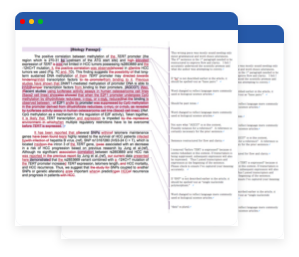圆括号( )和方括号[ ]
圆括号( )是一对圆形的括号,用于括起诸如数字、词汇、短语或句子的补充信息。在学术写作中,公式、首字母缩写词和文章中的参考文献引用通常要放在圆括号内。需要注意的是,英文的圆括号()与中文的圆括号()占格大小不一样,不应混淆。方括号[ ]用于括起直接修饰前文内容的数字、词汇、短语或句子,目的是为了给予澄清注释。圆括号和方括号都用来给读者提供额外信息,但是这两种括号的用法可能令人迷惑。这份指南简述这两种括号的区别,以及如何正确使用它们。
目录
- 1.圆括号与方括号的区别
- 2.并列圆括号
- 3.嵌套圆括号和方括号
- 4.圆括号或方括号与周围其他标点符号的关系
圆括号与方括号的区别
圆括号与方括号之间的最大区别是圆括号用来向读者提供额外的信息,而方括号用来向读者提供澄清的信息。例如,在句子中使用圆括号是为了添加进一步的解释、首字母缩写词或作者想要补充的其他支持性信息。因此,包含圆括号的句子的含义不会因为删除圆括号而改变。
- Example
- The COO position went to Sam Anderson (the son of the current CEO).
- Example
- He received a generous bonus ($5,000) from work.
方括号则主要用于添加不是原来说那个话的人所说的澄清性内容。使用方括号的目的是为了向读者澄清方括号前面那些别人所说的词语的含义。
- Example
- He drove 130 [kilometers per hour] on the highway.
- Example
- It was hard for her to finish it [her writing assignment].
并列圆括号
当在一个短语或句子中需要把两个或多个圆括号放在一起使用时,可以使用并列圆括号。并列圆括号的使用规则视不同的学术写作指南而定。
APA 文献格式建议只使用一个圆括号,并用分号分隔圆括号里面的元素。
- Example
- The results of the study were submitted by the Centers for Disease Control and Prevention (CDC; Odin, 2018).
芝加哥文献格式也是建议只使用一个圆括号;但如果圆括号内的元素互不相关,则允许使用并列圆括号,并必须用一个空格把相邻的括号隔开。
- Example
- The results of the study were submitted by the Centers for Disease Control and Prevention (CDC), (Odin, 2018).
嵌套圆括号和方括号
嵌套圆括号是套在外层圆括号中的内层圆括号。嵌套括号是这样表示的:(括号内文字(嵌入文字) 括号内文字)。
用英式英语撰写的学术文章经常出现嵌套圆括号。但是,如有可能,最好能够避免使用嵌套圆括号,最好只使用一对圆括号和/或英文破折号。
用美式英语撰写的学术文章也可以使用嵌套圆括号。但是和英式英语一样,也是建议尽量只使用一对圆括号。如果实在难以避免使用嵌套圆括号,建议对内嵌文字元素使用方括号,这种用法称为外圆内方的嵌套括号用法。
- Incorrect
- (Additional information is available on the website (website link) of the journal.)
- Correct
- (Additional information is available on the website [website link] of the journal.)
另一种嵌套括号的用法是外方内圆,通常是把方括号括在带有圆括号的计量单位外面。这种情况在插图的横轴或纵轴的单位标注方面尤为常见。
- Incorrect
- The engine fuel consumption is 300 g/(kW⋅h) in the SI unit (or 0.493 lb/(hp⋅h) in the British unit).
- Incorrect
- The engine fuel consumption is 300 g/(kW⋅h) in the SI unit (or 0.493 lb/[hp⋅h] in the British unit).
- Correct
- The engine fuel consumption is 300 g/(kW⋅h) in the SI unit [or 0.493 lb/(hp⋅h) in the British unit].
- Incorrect
- Axis of figure label: Engine fuel consumption (g/(kW⋅h))
- Incorrect
- Axis of figure label: Engine fuel consumption (g/[kW⋅h])
- Correct
- Axis of figure label: Engine fuel consumption [g/(kW⋅h)]
圆括号或方括号与周围其他标点符号的关系
圆括号内的内容应作为句子中的独立元素来处理。标点符号(例如句号、问号和感叹号)可以根据不同的情况放在圆括号或方括号的里面或外面。
-
如果圆括号或方括号内的短语是一个完整的句子,句号应该放在括号里面。
- Incorrect
- I want to go home. (I'm so tired.)
- Correct
- I want to go home. (I'm so tired).
-
如果圆括号或方括号内的短语不是一个完整的句子,那么句号应该放在括号外面。
- Incorrect
- The study will continue into the future (until May 2021.)
- Correct
- The study will continue into the future (until May 2021).
-
当圆括号或方括号出现在句中子句的末尾时,逗号要放在括号外面,或不放逗号。
- Incorrect
- The chart for this data (number of women in the workplace,) is incorrect and the argument should be revised.
- Correct
- The chart for this data (number of women in the workplace) is incorrect and the argument should be revised.
-
如果圆括号或方括号内的短语后面需要使用问号或感叹号,那么问号或感叹号应该放在括号里面。
- Incorrect
- The woman (the one with a blue dress)! visited me.
- Correct
- The woman (the one with a blue dress!) visited me.
-
如果用括号括起来的短语后面包含问号或感叹号,则在置于句末的圆括号或方括号后面需要添加一个句号。
- Incorrect
- I can't believe he didn't invite me (after all I did for him!)
- Correct
- I can't believe he didn't invite me (after all I did for him!).
小贴士: 在您掌握了这些括号使用规范后,如果想进一步提升写作的准确性和专业性,可以尝试使用 Wordvice AI 在线语法检查工具,它能智能识别括号位置不当、中英文格式混用等常见问题,并提供实时修改建议。无论是简单的日常写作还是严谨的学术论文,这个工具都能帮助您更自信地运用括号,让文章表达更加清晰规范。






